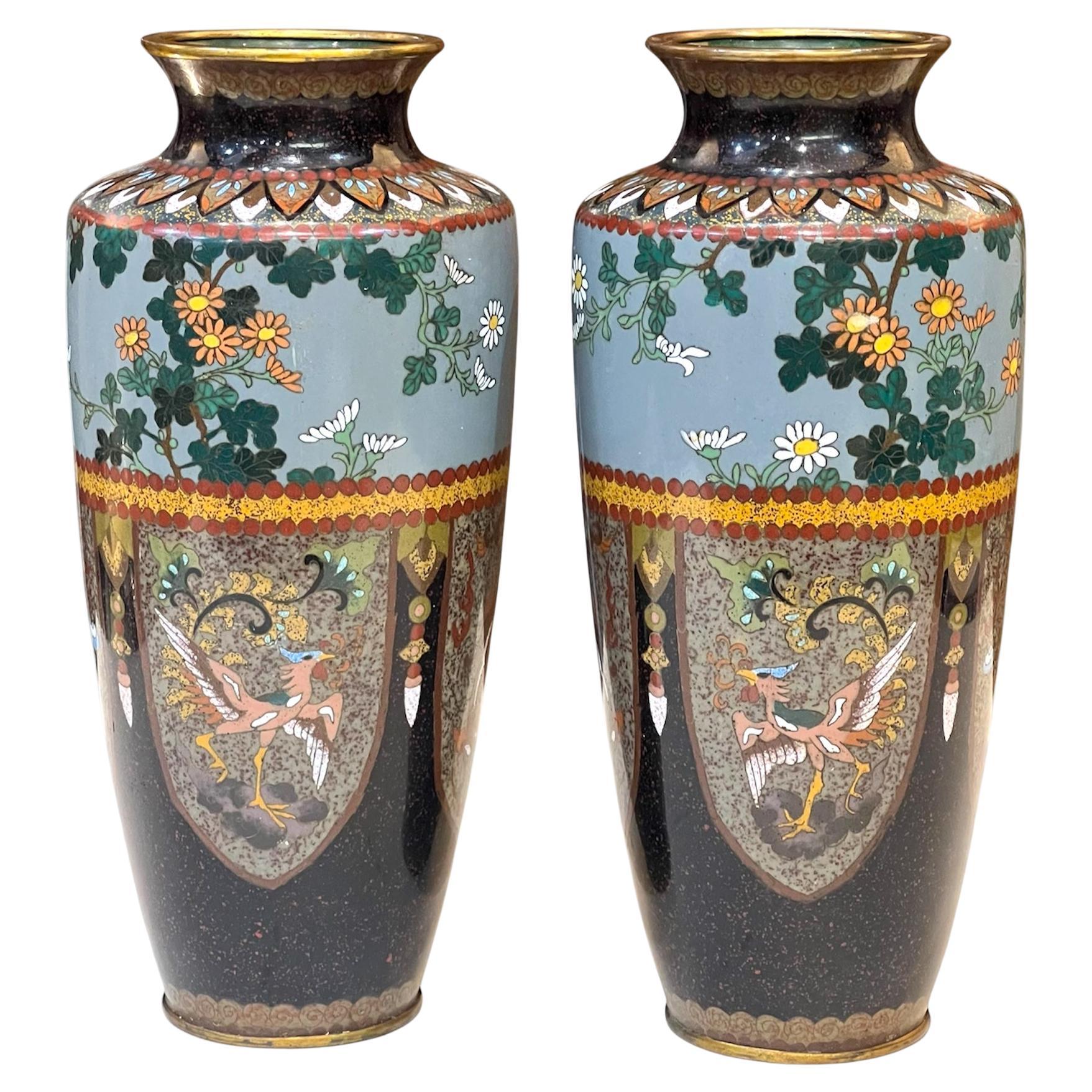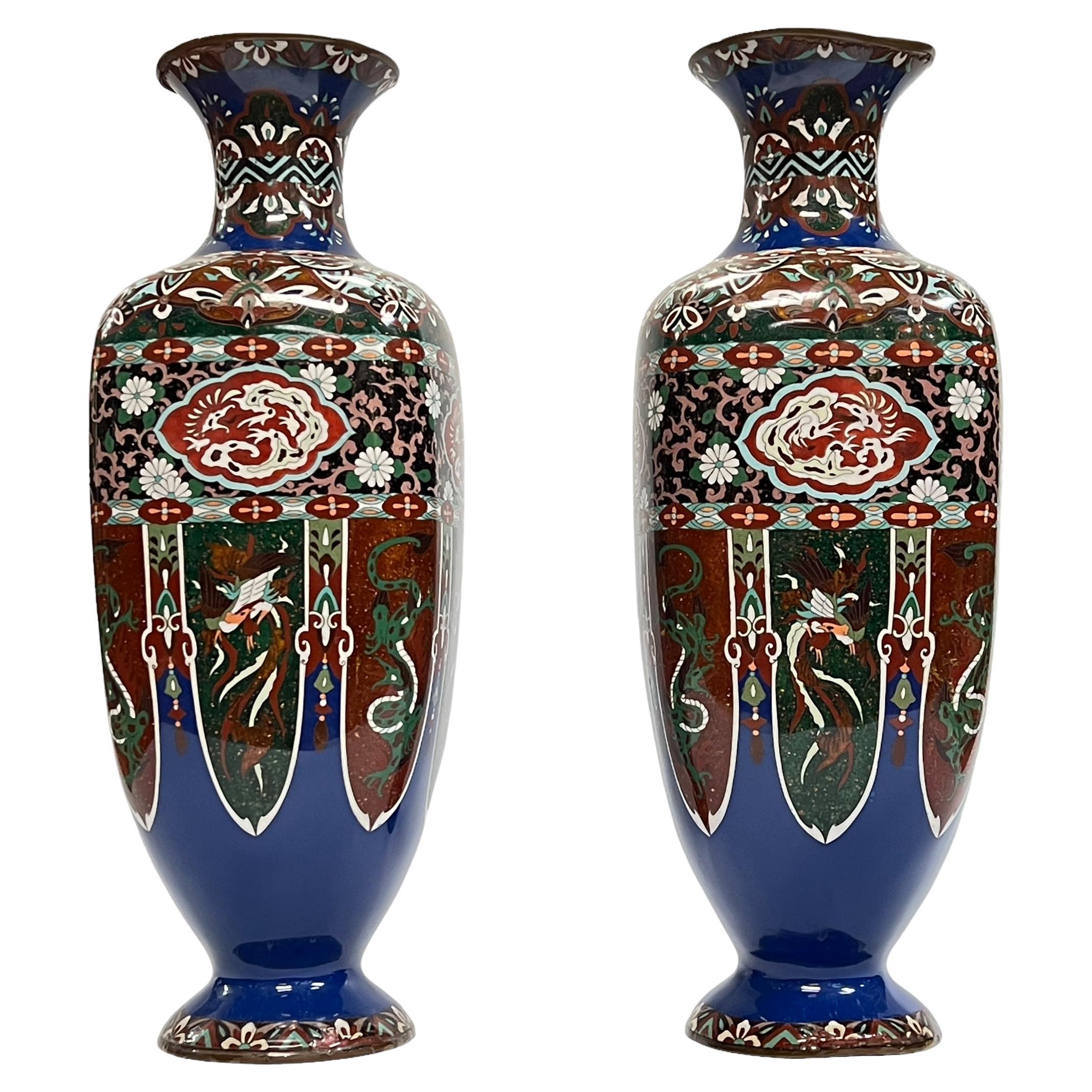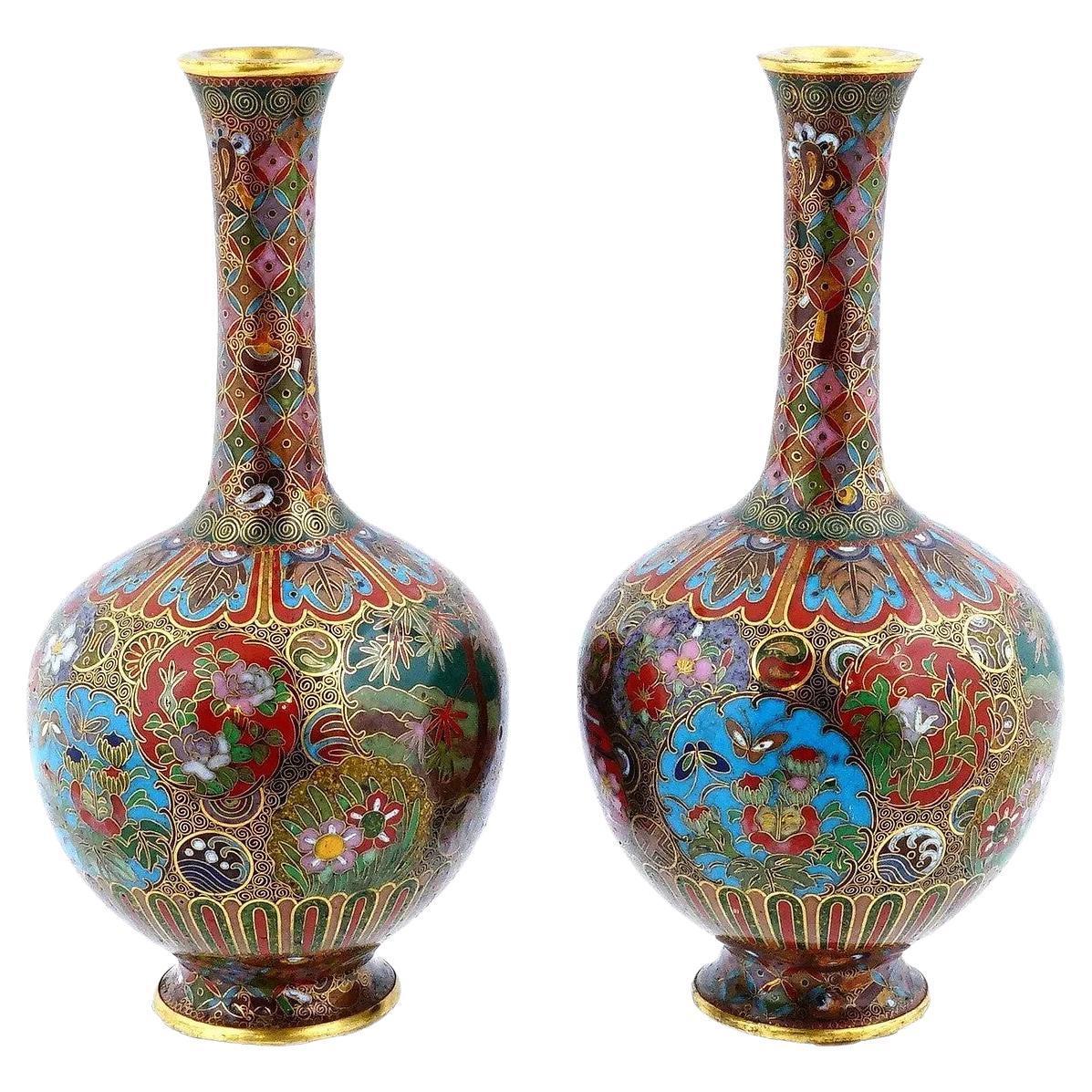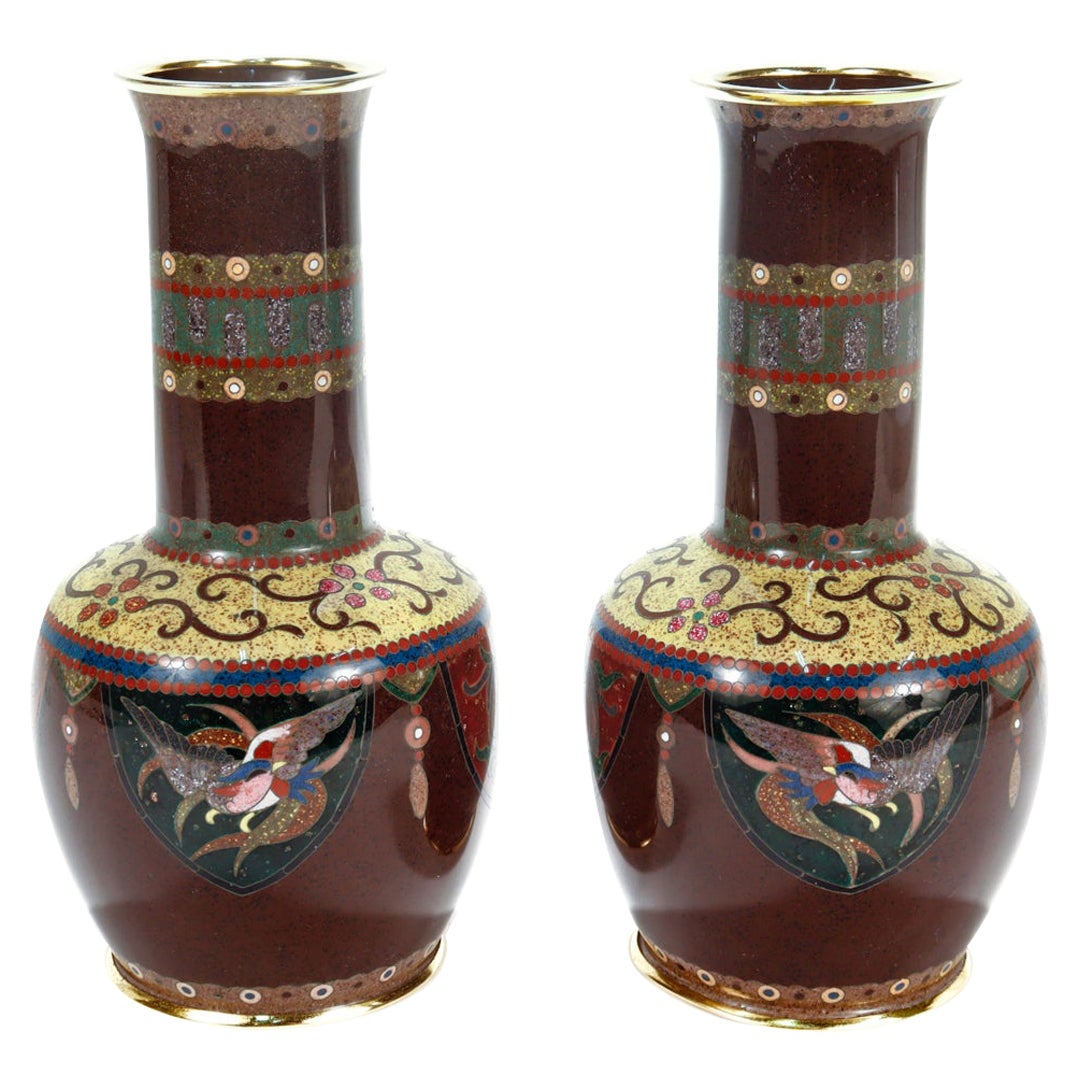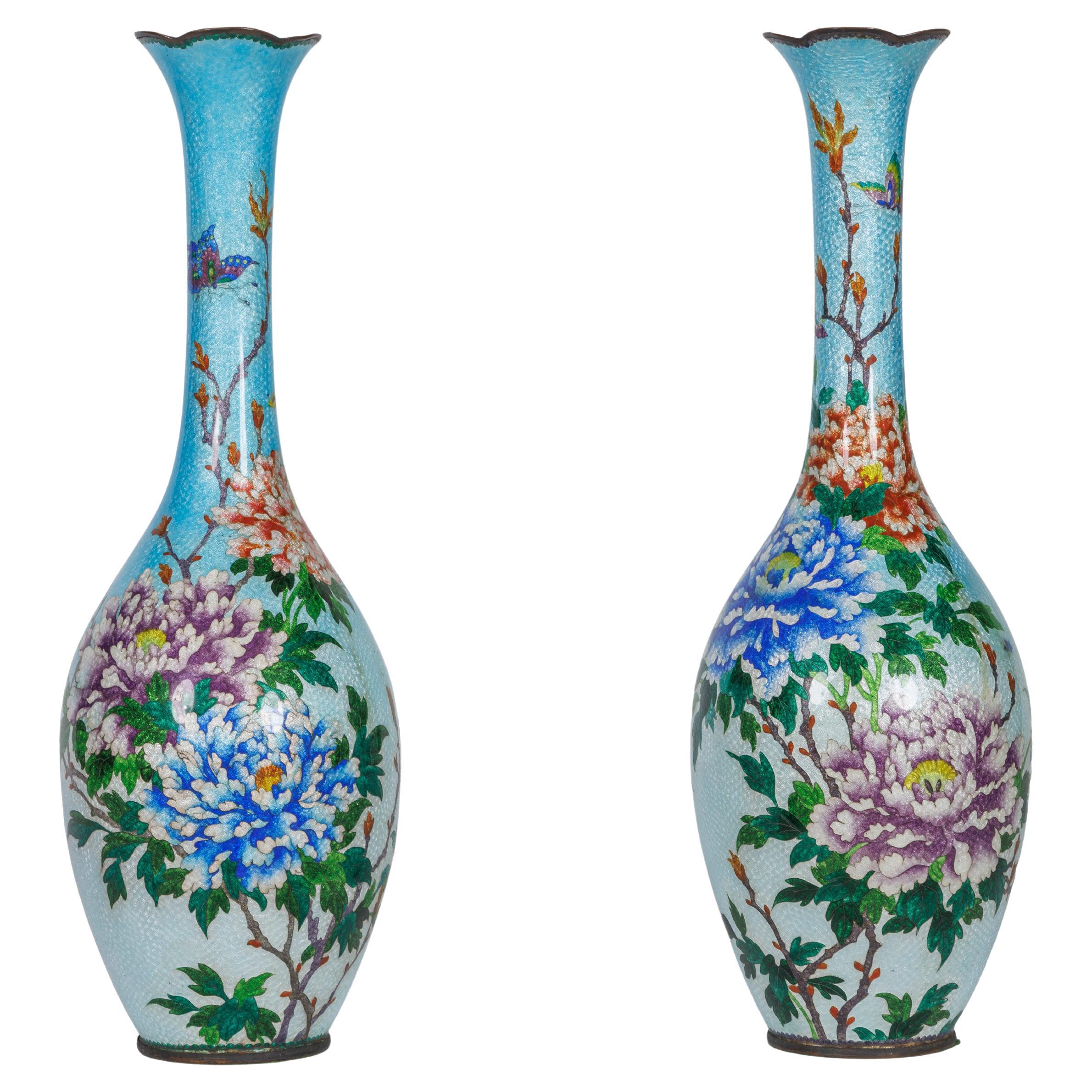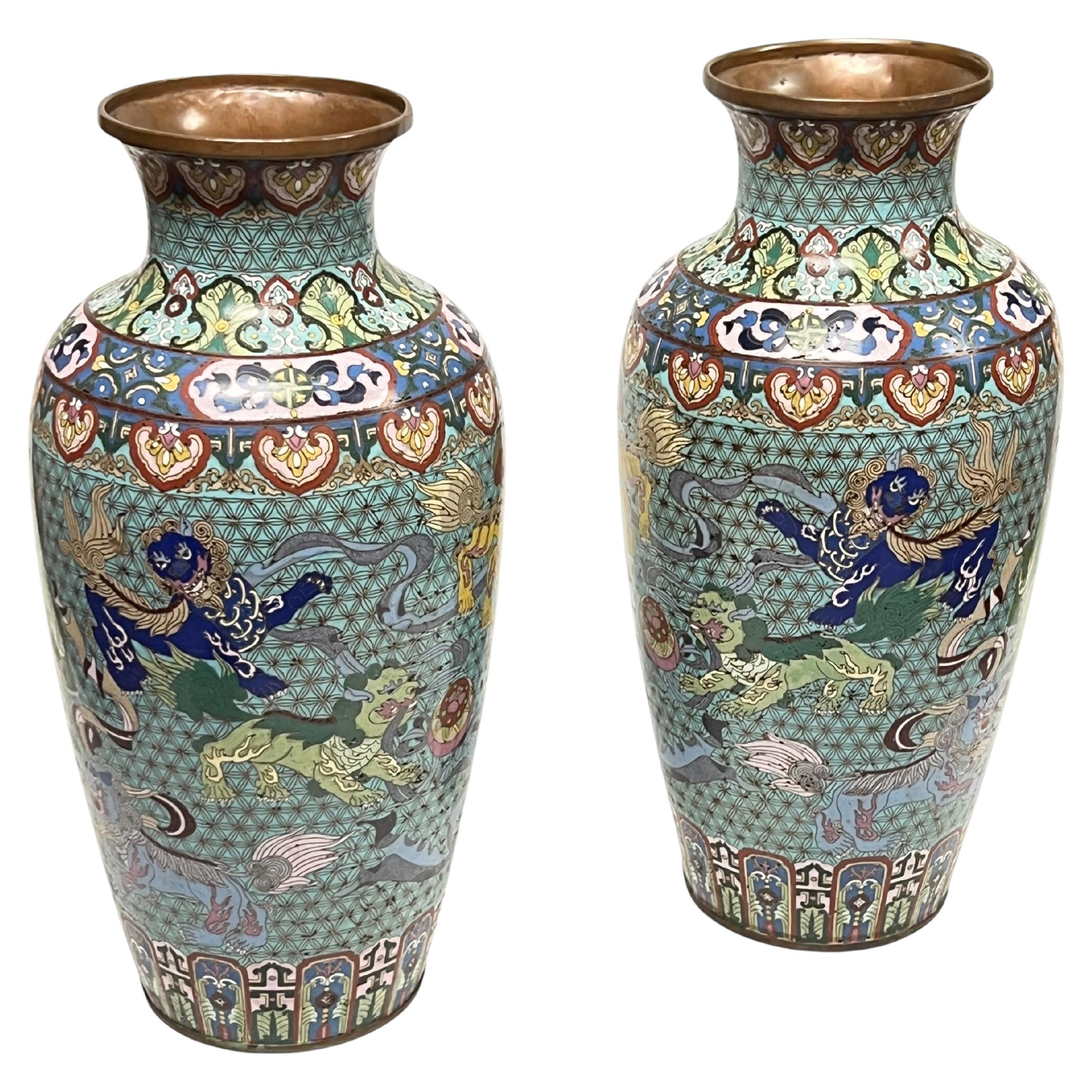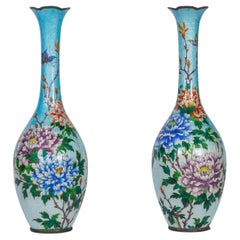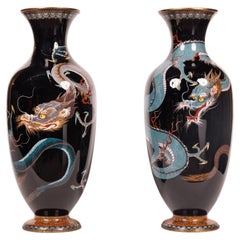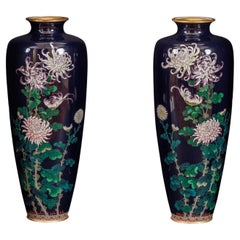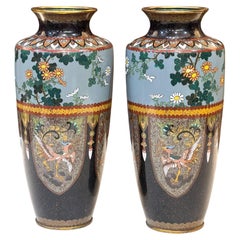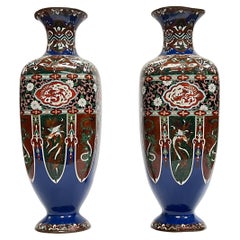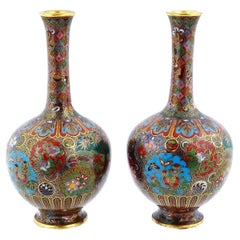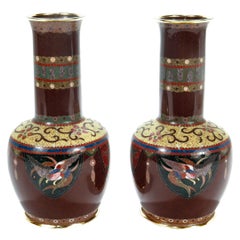Items Similar to Large Pair of Japanese Cloisonne Enamel Vases Attributed to Honda Yasaburo
Video Loading
Want more images or videos?
Request additional images or videos from the seller
1 of 22
Large Pair of Japanese Cloisonne Enamel Vases Attributed to Honda Yasaburo
$65,000
£49,026.79
€56,626.43
CA$91,069.48
A$101,264.03
CHF 53,013.55
MX$1,236,959.10
NOK 666,167.48
SEK 626,664.02
DKK 422,712.42
About the Item
A large pair of Japanese Cloisonne Enamel vases attributed to Honda Yasaburo, 19th century.
Finley decorated with the rich enamel colors of orange and green, these vases are designed with birds, phoenix, dragons, lotus and paulownia flowers and the traditional Japanese Karakusa pattern.
Karakusa is a decorative motif commonly used in traditional Japanese art and design. The word "karakusa" refers to a type of plant, often translated as "Arabesque" in English, which features a twisting and curling vine-like stem with leaves and flowers.
The karakusa pattern is created by repeating this vine-like stem in a continuous pattern, often with various other elements such as flowers, fruits, and leaves. The pattern can be found in a variety of mediums, including textiles, ceramics, and lacquerware.
The karakusa pattern has a long history in Japanese art and design, dating back to the Heian period. It was often used as a decorative element in clothing, such as the kimono, and in architecture, such as in the decorative elements of temples and shrines.
Today, the karakusa pattern is still a popular decorative element in Japanese art and design. It is often used in modern designs for textiles, stationery, and other decorative items. The pattern has also been adapted and incorporated into contemporary Western designs, often used in fashion, home decor, and graphic design.
Honda Yasaburo was a renowned Japanese cloisonne artist who lived and worked during the Meiji period (1868-1912) in Japan. He was born in 1845 in Nagoya, Japan, and studied under the famous cloisonne artist Namikawa Yasuyuki.
He was known for his exceptional skill and attention to detail in cloisonne enamel work, and his pieces are highly sought after by collectors today. His works often featured intricate designs with bold colors and gold accents, and he was particularly skilled at creating realistic depictions of animals, birds, and flowers.
Honda Yasaburo's works were exhibited in international expositions, including the Paris Exposition Universelle in 1900, where he won a Gold Medal for his cloisonne enamel vase. He was also awarded the prestigious title of "Teishitsu Gigei-in" (Imperial Household Artist in 1910 by Emperor Meiji.) in 1910 by Emperor Meiji.
Today, Honda Yasaburo's works can be found in major museums and private collections around the world. They represent not only exceptional artistry but also the cultural and historical significance of the Meiji period in Japan.
Measures: 19.5" high x 12" wide.
In overall very good condition, no damages noted.
- Dimensions:Height: 19.5 in (49.53 cm)Diameter: 12 in (30.48 cm)
- Style:Meiji (Of the Period)
- Materials and Techniques:
- Place of Origin:
- Period:
- Date of Manufacture:19th Century
- Condition:Wear consistent with age and use.
- Seller Location:Queens, NY
- Reference Number:1stDibs: LU1798233535212
About the Seller
5.0
Vetted Professional Seller
Every seller passes strict standards for authenticity and reliability
Established in 1980
1stDibs seller since 2016
63 sales on 1stDibs
Typical response time: 1 hour
- ShippingRetrieving quote...Shipping from: Queens, NY
- Return Policy
Authenticity Guarantee
In the unlikely event there’s an issue with an item’s authenticity, contact us within 1 year for a full refund. DetailsMoney-Back Guarantee
If your item is not as described, is damaged in transit, or does not arrive, contact us within 7 days for a full refund. Details24-Hour Cancellation
You have a 24-hour grace period in which to reconsider your purchase, with no questions asked.Vetted Professional Sellers
Our world-class sellers must adhere to strict standards for service and quality, maintaining the integrity of our listings.Price-Match Guarantee
If you find that a seller listed the same item for a lower price elsewhere, we’ll match it.Trusted Global Delivery
Our best-in-class carrier network provides specialized shipping options worldwide, including custom delivery.More From This Seller
View AllAn Exquisite and Large Pair of Meiji Japanese Ginbari Cloisonne Enamel Vases
Located in Queens, NY
An Exquisite and Large Pair of Meiji Japanese Ginbari Cloisonné Enamel Vases with Peonies and Butterflies
This stunning pair of vases, crafted during the Meiji period (1868-1912), s...
Category
Antique 19th Century Japanese Meiji Vases
Materials
Enamel
Large Pair of Meiji Period Japanese Cloisonne Enamel Double Dragon Vases
Located in Queens, NY
A large pair of Meiji Period Japanese Cloisonne Enamel Double Dragon Vases, 19th century.
Japanese cloisonne enamel dragon vases are highly ...
Category
Antique 19th Century Japanese Meiji Metalwork
Materials
Copper, Enamel
Monumental Pair of Japanese Cloisonné Enamel Vases with Warriors, Ota Tamashiro
Located in Queens, NY
A Monumental Pair of Japanese Meiji Period Cloisonné Enamel Vases with Warriors, Dragon, and Falcon, Attributed to Ota Tamashiro
A monumental pair of Japanese cloisonné enamel vases...
Category
Antique 19th Century Japanese Meiji Vases
Materials
Copper, Enamel
An Exquisite Pair Of Japanese Cloisonné Enamel Vases with Chrysanthemum Blossoms
Located in Queens, NY
An Exquisite Pair Of Japanese Cloisonné Enamel Vases with Chrysanthemum Blossoms, Attributed to Hayashi, Meiji Period.
Experience the exquisite craftsmanship of the Meiji period wit...
Category
Antique 19th Century Japanese Meiji Metalwork
Materials
Enamel
Large Pair of Japanese Cloisonne Enamel Lanterns Attributed to Kaji Tsunekichi
Located in Queens, NY
A Large Pair of Japanese Cloisonne Enamel Lanterns Attributed to Kaji Tsunekichi, Edo Period, 19th century
Japanese cloisonne lanterns were made during the Meiji period, from the late 19th to early 20th century, and were often used as decorative lighting fixtures in temples and shrines.
Kaji Tsunekichi (1866-1916) was a Japanese cloisonné artist who was active in the late 19th and early 20th centuries. He was born in Tokyo and learned the art of cloisonné from his father, Kaji Sataro, who was also a cloisonné artist. He was renowned for his mastery of the shippo-yaki technique, which involves creating intricate designs with thin wires on a metal base before filling in the spaces with enamel.
Tsunekichi was known for his exceptional technical skills and his ability to create intricate designs with vibrant colors. His works often featured nature motifs, such as flowers, birds, and fish, which were rendered in a highly detailed and naturalistic style. He also experimented with new techniques, such as plique-à-jour, a type of cloisonné that creates a stained-glass effect.
Tsunekichi's works were highly prized during his lifetime and continue to be sought after by collectors today. He won numerous awards for his cloisonné creations, including a Gold Medal at the 1900 Exposition Universelle in Paris. His works are characterized by their fine wirework, precise enamel application, and attention to detail.
Some of Tsunekichi's most famous works include a pair of large cloisonné vases...
Category
Antique 19th Century Japanese Edo Metalwork
Materials
Copper, Enamel
A Large Pair of Japanese Cloisonne Pink-Ground Vases Featuring Sunset and Cranes
Located in Queens, NY
Presenting a truly captivating and highly collectible pair of Meiji Period Japanese Cloisonné Enamel Pink-Ground Vases, attributed to the renowned artist Hayashi Kodenji. These excep...
Category
Antique 19th Century Japanese Meiji Vases
Materials
Enamel
You May Also Like
A Fine pair of Japanese cloisonné enamel vases Attributed to Honda Yasaburō
Located in London, GB
A Fine pair of Japanese cloisonné enamel vases
Attributed to Honda Yasaburō, Nagoya,
Meiji era
Each of baluster form, worked in polychrome enamels and silver wire on a mottled da...
Category
Antique 19th Century Japanese Metalwork
Materials
Enamel
Pair Large Japanese Cloisonne Enamel Metal Vases
Located in New York, NY
Pair of brilliant blue Japanese Meiji period cloisonne enamel metal vases with rounded square shape. Each 24 by 8 1/2 by 10 inches.
Category
Antique 19th Century Japanese Metalwork
Materials
Metal
$4,500 / item
Pair Of Meiji Japanese Cloisonne Enamel Vases Kyoto School
Located in Long Island City, NY
A pair of Japanese cloisonne enameled brass vases. They feature a narrow neck, rounded body, and are decorated with an intricate pattern of floral designs in various colors, and gilt...
Category
Antique Late 19th Century Japanese Vases
Materials
Brass, Enamel
Pair of Signed Antique Japanese Cloisonne Enamel Vases by Daikichi
By Ando Jubei, Ando Shippo Ten, Kumeno Teitaro
Located in Philadelphia, PA
A fine pair of Japanese Meiji period cloisonne enamel vases.
By the Ohta Cloisonne workshop of Aichi Prefecture, Japan. T...
Category
20th Century Japanese Meiji Metalwork
Materials
Enamel
Pair Exceptional Antique Japanese Meiji Period Cloisonne Enameled Metal Vases
Located in New York, NY
Pair of exceptional antique (late 19th century) Meiji period Japanese metal vases with fine cloisonne enameled designs of guardian lions and dragons. Each 20 1/4 inches tall and 9 i...
Category
Antique Late 19th Century Japanese Meiji Metalwork
Materials
Metal
Pair Japanese Cloisonné Vases with Unusual Bottom Decoration, 19th century
Located in Atlanta, GA
Brass vases with a turquoise leaf field background with a bright floral ground, flowers of white, red, and cobalt blue, the bottoms decorated with leaves and a single flower
Category
Antique 1880s Japanese Vases
Materials
Brass, Enamel
More Ways To Browse
Emperor Japan
Japanned English Furniture
Orange Japanese Antique
Asian Shrine
Antique Clothing Museum
Gold Enamel Dragon
Cloisonne Collection
Antique Stationery
Green Dragon Vase
Cloisonne Enamel Dragon
Green Cloisonne Vase
Japanese Antique Shrines
Green Kimono
Cloisonne Dragon Vase
Japanese Cloisonne Dragon
Meiji Cloisonne Dragon
Kimono Meiji
Kimono Orange
